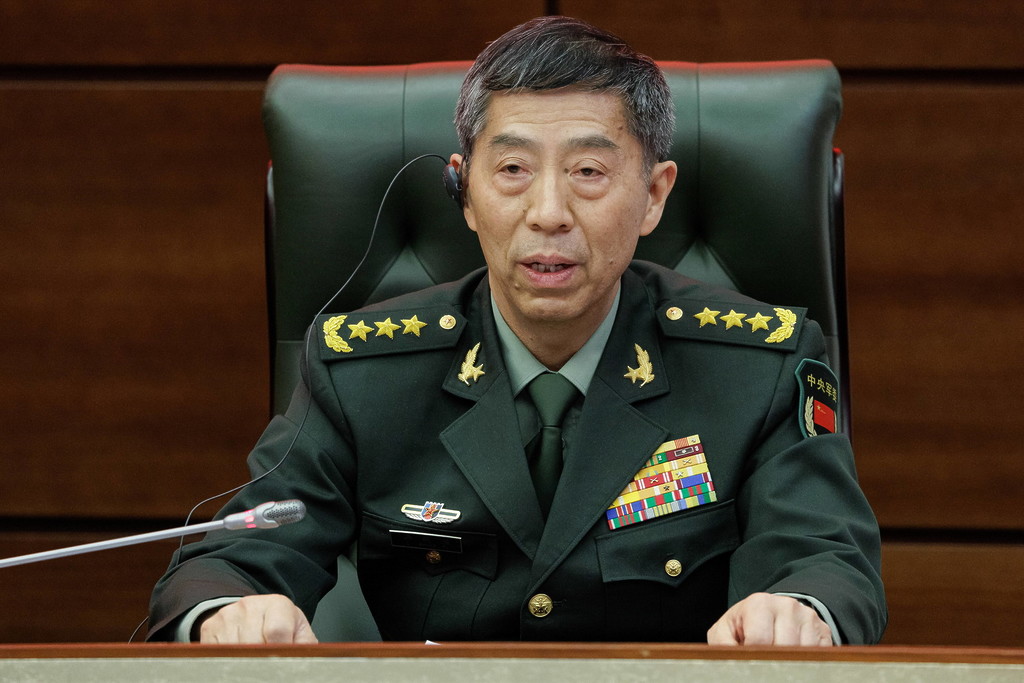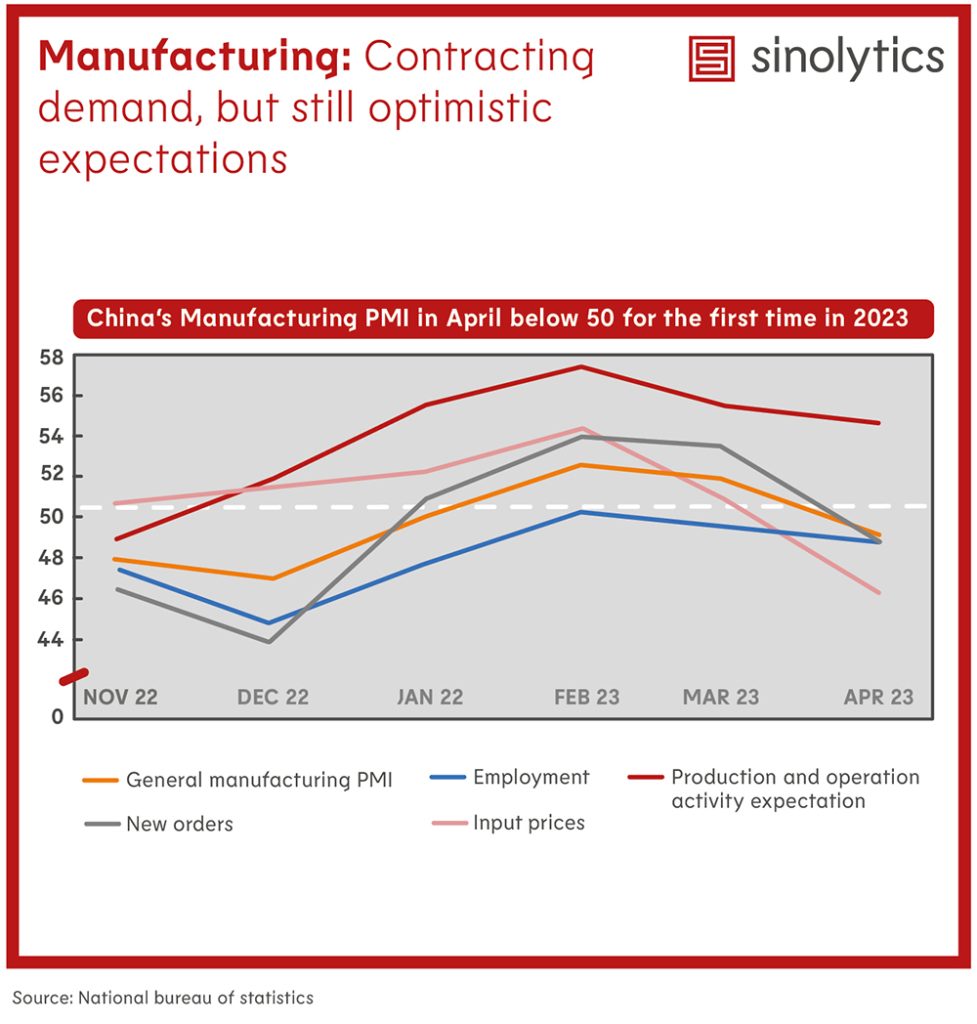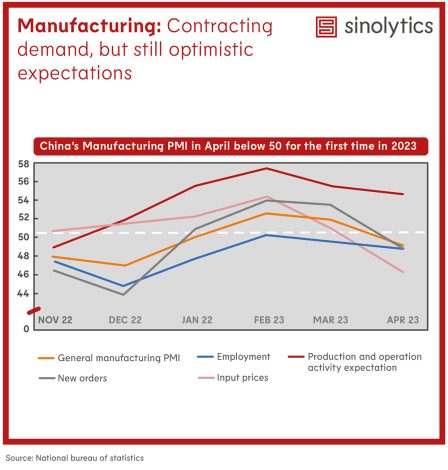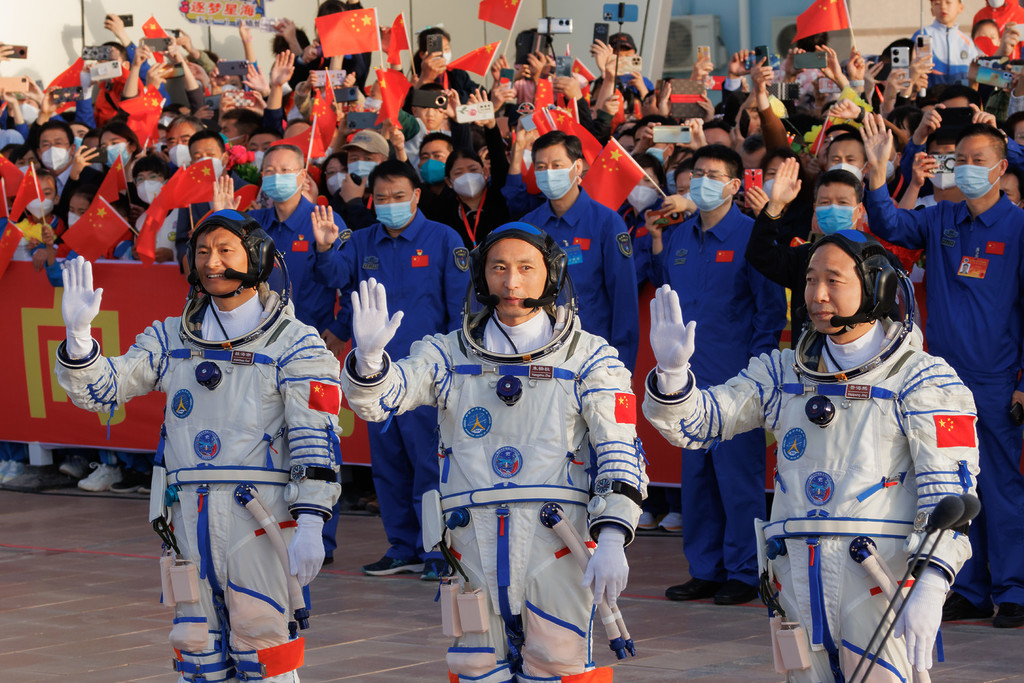With its “Belt and Road” initiative, Beijing wants to gain international significance. However, this global power is not only expressed by political influence or large and the occasional transnational infrastructure project, but above all in technical details.
Chinese companies establish their technological norms and standards in the countries of the so-called New Silk Road, for instance in 5G or high-speed trains. This allows Beijing to bind the countries to its economic sphere in the long term. After all, whoever sets the standards in one area soon dominates all related sectors with their products. Finn Mayer-Kuckuk analyzes how far this development has already progressed.
Meanwhile, there is a lack of standards for communication between the Chinese and US defense ministries. Most recently, Chinese Minister of Defence Li Shangfu refused to speak to his US counterpart Lloyd Austin on the sidelines of the Shangri-La Security Dialogue in Singapore.
Only if the United States “immediately corrects its wrong practices” and “creates the necessary atmosphere” for a meeting will there be a willingness to talk. One reason: Washington has sanctioned Li. A genuine exchange appears increasingly impossible considering the growing diametrically opposing positions, as Fabian Kretschmer analyzes. And this silence is dangerous.


With the Silk Road project, China entered international cooperation as a major player in 2013 – and norms and standards have been an important part of the strategy from the beginning. “China plays an active role in setting standards within the framework of the Belt and Road Initiative,” says Tim Ruehlig from the Center for Geopolitics, Geo-economics and Technology at the German Council on Foreign Relations (DGAP). “This gives it increasing power and influence in the competition of digital technologies.”
So far, 151 countries have joined the Belt and Road Initiative (BRI). A round trillion euros in funding has already been distributed as part of the projects – no one knows precisely how much. Since 2015, the money stream has slowed down somewhat, but China has long since become the most important partner for many previously neglected countries.
Setting technical standards is not a one-off process in which China imposes rules on a partner country. Instead, it is an ongoing process, as Ruehlig explains. Chinese companies provide impetus for local standardization by offering their products. Most of the time, the demand for technical regulation by the respective state happens on its own after a product has established itself. Then Chinese government agencies immediately step in as advisors. Just a few technology generations later, Chinese standards dominate.
Example 5G: Huawei and ZTE have not only become global market leaders thanks to good business in Europe. They have introduced fast telecommunication networks to vast areas in large parts of the Global South, especially along the Silk Road. Although the mobile phone industry has agreed internationally on the open platform, Open RAN – at least for devices that transmit directly to the consumer – China dominates technical development and plays a decisive role in setting the standard.
Example train technology: The railroad cars of Chinese high-speed trains may be based on the Shinkansen, ICE, and TGV, but the signaling technology is from Chinese development. The systems are incompatible with their Western or Japanese counterparts. DGAP expert Ruehlig suspects intent here. Exporting train technology has been a goal of Chinese railway expansion from the outset. Silk Road countries receiving their first modern railway lines immediately commit to Chinese signaling standards.
According to Rühlig, those who set technical standards have several advantages:
The USA and Europe have set the majority of technical standards in the past. However, there are differences in China’s approach. “In the US, technical standards are written mainly by private actors,” says Rühlig. “In China, the party-state plays a much bigger role.” So Beijing politicizes standards.
However, setting technical standards along the Silk Road is not the only thing that gives China an edge; it is also the fact that it does not impose ethical requirements on recipient countries. While the EU wants to focus on clean supply chains in the future, China is not setting up any hurdles of this kind for trade. The term for this is the principle of unconditional cooperation.
The principle is officially applied and expressed. At the China-Africa Forum 2018, Beijing formulated the “five no” approach:
The pattern is only logical: China sets technical standards because it is technically sound – but for obvious reasons, it does not set standards regarding democracy or transparency. Beijing demands non-interference itself and offers it to others.
In other words, China exports its own low ethical standards. Especially in countries with corruption problems, the BRI billions only exacerbate the problems.
However, Beijing’s leaders have not been unaware of how damaging such events are to the BRI’s reputation. Not least, China itself is part of the UN Convention against Corruption. For this reason, it proclaimed purging its BRI project of corruption in 2019. It is now “green and clean,” Xi Jinping said proudly.
The “green” marks an important change in direction that has already taken place. In 2015, Beijing attached environmental standards to the allocation of Silk Road funds and, since then, has been adhering to them more and more (with exceptions). This, too, is logical; After all, China portrays itself as a green pioneer.

Over the weekend, US Secretary of Defense Lloyd Austin requested a meeting with his Chinese counterpart Li Shangfu. The talks would have taken place on the sidelines of the Shangri La Security Dialogue in Singapore and were intended to de-escalate the high tensions between the two superpowers. But this did not happen: Beijing rejected the Americans’ offer for talks with unusually harsh words. On Tuesday, the Chinese government underlined its position. There will only be talks when the United States “immediately corrects its wrong practices” and creates “the necessary atmosphere and conditions for dialogue.”
But both sides should talk about the military in particular. A military conflict no longer seems merely a conceivable scenario, but at times a likely event. Anyone who listens to Washington think tanks or Beijing government conferences these days are often shocked at how the two sides perceive each other. For the international community, the cold relations between the two leading economies are a cause for deep concern.
The fact that even some of the most basic communication channels between the two states have now broken down only increases the risk. In 2013, a total of 40 bilateral meetings were held between military representatives; last year, there were only four. But talks are essential, especially for the military – if only to avoid misunderstandings and accidental escalations should the worst happen. There have been plenty of potential occasions in the recent past, most recently the downing of the Chinese spy balloon off American territory. In the South China Sea, too, experts regularly warn of accidental collisions between ships or aircraft of both countries.
There is an obvious reason for the increasing refusals from Beijing: China’s Minister of Defense Li Shangfu has been on the US sanctions list since the fall of 2018 because, according to the White House, he was involved in “significant transactions” involving, among other things, the supply of Russian fighter jets to China. “If the US Secretary of Defense was under sanctions from the Chinese, would he accept a request for a meeting?” commented Dennis Wilder, a sinologist at Washington’s Georgetown University.
At least there has recently been renewed contact in other political areas. In early May, US Ambassador Nicholas Burns met with Chinese Foreign Minister Qin Gang, and China’s top diplomat Wang Yi met with Jake Sullivan, Biden’s National Security Advisor, in Vienna. Minister of Commerce Wang Wentao met his counterpart Gina Raimondo and Trade Representative Katherine Tai in the US. US President Joe Biden even announced a coming “thaw” shortly after the G7 summit. Foreign Minister Qin Gang welcomed Tesla CEO Elon Musk in Beijing on Tuesday and promised to continue the opening policy.
But at the same time, the tech war between the two continues unabated. Beijing recently responded to the ever-growing list of US sanctions by issuing a partial sales ban in China on Micron Technology, the largest US memory chipmaker. So things remain complicated.
The rejection of the military dialogue is thus not a good sign. The incentives for China to pursue a dialogue with the US government on sensitive matters are also extremely low due to the timing. Beijing is well aware of the election cycle in Washington and the fact that populist vote-catching is already influencing the actions of the US government. Moreover, any effort invested is an uncertain bet on the future: By January 2025, a different president could already be in office, possibly even Donald Trump again. The Communist Party’s time horizon, on the other hand, stretches over decades.
Beyond that, a growing number of CP cadres in Beijing are apparently concluding that any dialogue with the USA would be a waste of time anyway. They say the positions are diametrically opposed, and a substantive exchange is almost impossible. And in the end, it is said, Washington would stick to the accused “containment policy” anyway. The USA would by no means tolerate a new number one.
In a statement to the Wall Street Journal, a spokesperson for the Chinese embassy in Washington puts it unequivocally: The US is “seeking to suppress China through all possible means and continue imposing sanctions on Chinese officials, institutions and companies.” (…) Is there any sincerity in and significance of any communication like this?”
In the past, Beijing argued that a largely peaceful succession of one world power by the next was possible – as was the case, for example, between the United Kingdom and the United States in the early 20th century. In the meantime, however, they refer almost exclusively to the so-called Thucydides Trap. It describes – in historical reference to the conflict between Athens and Sparta – the high probability of war when a rising power threatens to replace an existing hegemony.
However, given the slow economic recovery, the threat of demographic change and geopolitical tensions, China’s path to the top is likely to take much longer than most economists had predicted even before the pandemic. Fabian Kretschmer, Collaboration: Christiane Kuehl


Sinolytics is a European research-based consultancy entirely focused on China. It advises European companies on their strategic orientation and concrete business activities in the People’s Republic.
The stricter interpretation of the planned EU supply chain law is hanging in the balance. Within the EPP, the largest group in the EU Parliament, resistance is currently forming against the report, which will be voted on in the plenary on Thursday. The liberal Renew Group has also expressed some reservations. The paper is supposed to serve as the basis for the Parliament’s negotiations with the other EU institutions; the EU Parliament had actually aimed for a strict interpretation.
The EU Supply Chain Act will also impact trade with China. Among other things, the debate focuses on the scope of the planned law and the accountability of company board members. “We as the CDU/CSU group will vote against the report on Thursday,” EPP Co-Chair Daniel Caspary told Table.Media. The politician said he also received “clear signals” from the other large EPP delegations that they, too, are critical of the draft. He also warned of a loss of EU competitiveness. The law would not improve conditions in poorer countries – but would lead to European companies withdrawing and leaving the field to Chinese competitors, for example, said Caspary.
If the report fails in plenary on Thursday, it will be returned to the Committee for reworking. It will be decided in the so-called trilogue: Besides the EU Parliament, the EU Council and the EU Commission will also be involved and submit their own drafts. we/ari
Following the return of Ukraine special envoy Li Hui to China, a Wall Street Journal report has sparked a debate about alleged remarks made by the diplomat. Li reportedly urged his interlocutors in Europe to press Kyiv for an immediate ceasefire, the US newspaper said, citing anonymous diplomats said to be familiar with the content of Li’s talks. However, Ukraine’s Foreign Minister Dmytro Kuleba rejected this account in a video post on Facebook.
Such a demand would be a breach of taboo, as it would effectively mean a freeze of the conflict along the current front – leaving Ukraine to cede the territories currently occupied by Russia. So far, China has officially stressed the sovereignty and territorial integrity of both conflict parties – albeit without details, and without condemning Russia’s invasion. “We explained that freezing the conflict is not in the interest of the international community unless there is withdrawal of Russian troops,” the Wall Street Journal quoted a diplomat said to have spoken with Li Hui.
Kuleba apparently reacted immediately after the report was published. “I immediately contacted my colleagues in the capitals that he visited,” he said in the video. None of them had confirmed negotiations with Li on recognizing occupied Ukrainian territories as Russian territory. “Therefore, I urge you to keep a cool head and use your common sense. There is no need to behave and react emotionally to every article. We control the process,” Kuleba said, adding that Kyiv will continue to talk with Beijing.
Li Hui initially met with Kuleba and President Volodymyr Zelenskiy in Kyiv during his peace mission. “There is no panacea to solve the crisis,” Li acknowledged after his meetings. He then flew to Berlin, Warsaw, Paris and Brussels. There, he was reportedly received mainly at the level of state secretaries; nothing is known about those meetings so far. Over the weekend, Li met with Foreign Minister Sergei Lavrov in Moscow. According to his ministry, the latter thanked China for its “balanced position” and willingness to play a positive role. ck

Three astronauts have launched to space for the first full crew rotation on China’s new Tiangong space station. Their “Shenzhou 16” spacecraft lifted off Tuesday on a “Long March 2F” carrier rocket from the Jiuquan spaceport in Gansu province. It reached orbit a little over fifteen minutes later. The solar sails also deployed as planned, according to the space agency.
“Shenzhou 16” is the fifth manned mission to the Chinese space station, which began regular operations earlier this year without much fanfare. In early May, a cargo flight carried supplies, food, spare parts and 600 kilograms of fuel to the Tiangong (“Heavenly Palace”) in preparation for the stay of the three new astronauts. They are to relieve their colleagues after six months in space – and will now stay on the Tiangong for about five months themselves. Among them is Gui Haichao, a scientist from Beijing University of Aeronautics and Astronautics, the first civilian in Chinese space history.
China plans to bring astronauts to the moon for the first time by 2030. The US is even planning another manned landing on the Earth’s satellite by the end of 2025. Both spacefaring nations are eyeing the moon’s south pole, where frozen water is presumed to exist. ck
The former head of the Chinese Center for Disease Control (CDC), George Gao, does not rule out the possibility that the Covid virus could have escaped from a laboratory. The scientist told a BBC News podcast. “You can always suspect anything. That’s science. Don’t rule out anything,” explained Gao, who has been Vice President of the National Natural Science Foundation of China since he departed from the CDC.
After the outbreak of Covid, Gao’s agency played a key role in determining the virus’s origins. To date, China’s government has rejected any suspicion that the disease originated in a laboratory in Wuhan. According to Gao, however, the Chinese government had conducted some sort of formal investigation of the Wuhan Institute of Virology (WIV), indicating that it did take the suspicion seriously. However, the CDC had not been involved in that investigation. However, Gao further stated that he had “heard” that “they haven’t found [any] wrongdoing.” fpe

In his now-classic 2018 book, AI Superpowers, Kai-Fu Lee threw down the gauntlet in arguing that China poses a growing technological threat to the United States. When Lee gave a guest lecture to my “Next China” class at Yale in late 2019, my students were enthralled by his provocative case: America was about to lose its first-mover advantage in discovery (the expertise of AI’s algorithms) to China’s advantage in implementation (big-data-driven applications).
Alas, Lee left out a key development: the rise of large language models and generative artificial intelligence. While he did allude to a more generic form of general-purpose technology, which he traced back to the Industrial Revolution, he didn’t come close to capturing the ChatGPT frenzy that has now engulfed the AI debate. Lee’s arguments, while making vague references to “deep learning” and neural networks, hinged far more on AI’s potential to replace human-performed tasks rather than on the possibilities for an “artificial general intelligence” that is close to human thinking. This is hardly a trivial consideration when it comes to China’s future as an AI superpower.
That’s because Chinese censorship inserts a big “if” into that future. In a recent essay, Henry Kissinger, Eric Schmidt, and Daniel Huttenlocher – whose 2021 book hinted at the potential of general-purpose AI – make a strong case for believing we are now on the cusp of a ChatGPT-enabled intellectual revolution. Not only do they address the moral and philosophical challenges posed by large language generative models; they also raise important practical questions about implementation that bear directly on the scale of the body of knowledge embedded in the language that is being processed.
It is precisely here that China’s strict censorship regime raises alarms. While there is a long and rich history of censorship in both the East and the West, the Communist Party of China’s Propaganda (or Publicity) Department stands out in its efforts to control all aspects of expression in Chinese society – newspapers, film, literature, media, and education – and steer the culture and values that shape public debate.
Unlike the West, where anything goes on the web, China’s censors insist on strict political guidelines for CPC-conforming information dissemination. Chinese netizens are unable to pull up references to the decade-long Cultural Revolution, the June 1989 tragedy in Tiananmen Square, human-rights issues in Tibet and Xinjiang, frictions with Taiwan, the Hong Kong democracy demonstrations of 2019, pushback against zero-COVID policies, and much else.
This aggressive editing of information is a major pitfall for a ChatGPT with Chinese characteristics. By wiping the historical slate clean of important events and the human experiences associated with them, China’s censorship regime has narrowed and distorted the body of information that will be used to train large language models by machine learning. It follows that China’s ability to benefit from an AI intellectual revolution will suffer as a result.
Of course, it is impossible to quantify the impact of censorship with any precision. Freedom House’s annual Freedom on the Net survey provides a qualitative assessment. For 2022, it awards China the lowest overall “Internet Freedom Score” from a 70-country sample.
This metric is derived from answers to 21 questions (and nearly 100 sub-questions) that are organized into three broad categories: obstacles to access, violations of user rights, and limits on content. The content sub-category – reflecting filtering and blocking of websites, legal restrictions on content, the vibrancy and diversity of the online information domain, and the use of digital tools for civic mobilization – is the closest approximation to measuring the impact of censorship on the scale of searchable information. China’s score on this count was two out of 35 points, compared to an average score of 20.
Looking ahead, we can expect more of the same. Already, the Chinese government has been quick to issue new draft rules on chatbots. On April 11, the Cyberspace Administration of China (CAC) decreed that generative AI content must “embody core socialist values and must not contain any content that subverts state power, advocates the overthrow of the socialist system, incites splitting the country or undermines national unity.”
This underscores a vital distinction between the pre-existing censorship regime and new efforts at AI oversight. Whereas the former uses keyword filtering to block unacceptable information, the latter (as pointed out in a recent DigiChina forum) relies on a Whac-a-Mole approach to containing the rapidly changing generative processing of such information. This implies that the harder the CAC tries to control ChatGPT content, the smaller the resulting output of chatbot-generated Chinese intelligence will be – yet another constraint on the AI intellectual revolution in China.
Unsurprisingly, the early returns on China’s generative-AI efforts have been disappointing. Baidu’s Wenxin Yiyan, or “Ernie Bot” – China’s best-known first-mover large language model – was recently criticized in Wired for attempting to operate in “a firewalled Internet ruled by government censorship.” Similar disappointing results have been reported for other AI language processing models in China, including Robot, Lily, and Alibaba’s Tongyi Qianwen (roughly translated as “truth from a thousand questions”).
Moreover, a recent assessment by NewsGuard – an “internet trust tool” established and maintained by a large team of respected Western journalists – found that OpenAI’s ChatGPT-3.5 generated far more false, or “hallucinogenic,” information in Chinese than it did in English.
The literary scholar Jing Tsu’s remarkable book Kingdom of Characters: The Language Revolution that Made China Modern underscores the critical role that language has played in China’s evolution since 1900. In the end, language is nothing more than a medium of information, and in her final chapter, Tsu seizes on that point to argue that “Whoever controls information controls the world.”
In the age of AI, that conclusion raises profound questions for China. Information is the raw fuel of large language AI models. But state censorship encumbers China with small language models. This distinction could well bear critically on the battle for information control and global power.
Stephen S. Roach, a former chairman of Morgan Stanley Asia, is a faculty member at Yale University and the author, most recently, of Accidental Conflict: America, China, and the Clash of False Narratives (Yale University Press, 2022).
Christoph Karg has taken over the position of Area Sales Manager Asia at Venta Luftwaescher GmbH. The German company manufactures air humidification and air purification equipment. Karg studied in Taipei and gained China experience in Beijing, including as a project manager at the Friedrich Ebert Foundation.
Zhishuo Feng has been appointed Executive Director of China Nonferrous Gold, effective immediately. The Beijing-based listed gold mining company, which focuses on Tajikistan, made the announcement on Tuesday. Feng succeeds Hui Zhang, who has resigned.
Is something changing in your organization? Let us know at heads@table.media!

Amphibians are all the rage in China: All over the country, people are currently taking to the streets in frog costumes to dance, perform stunts – or simply behave in a way that social norms would otherwise forbid. Recently, street vendors, in particular, have discovered the trend to boost their sales. The costume was designed by an unemployed art student from Nanjing, who used it to sell toys on the street and subsequently went viral on China’s social media.
With its “Belt and Road” initiative, Beijing wants to gain international significance. However, this global power is not only expressed by political influence or large and the occasional transnational infrastructure project, but above all in technical details.
Chinese companies establish their technological norms and standards in the countries of the so-called New Silk Road, for instance in 5G or high-speed trains. This allows Beijing to bind the countries to its economic sphere in the long term. After all, whoever sets the standards in one area soon dominates all related sectors with their products. Finn Mayer-Kuckuk analyzes how far this development has already progressed.
Meanwhile, there is a lack of standards for communication between the Chinese and US defense ministries. Most recently, Chinese Minister of Defence Li Shangfu refused to speak to his US counterpart Lloyd Austin on the sidelines of the Shangri-La Security Dialogue in Singapore.
Only if the United States “immediately corrects its wrong practices” and “creates the necessary atmosphere” for a meeting will there be a willingness to talk. One reason: Washington has sanctioned Li. A genuine exchange appears increasingly impossible considering the growing diametrically opposing positions, as Fabian Kretschmer analyzes. And this silence is dangerous.


With the Silk Road project, China entered international cooperation as a major player in 2013 – and norms and standards have been an important part of the strategy from the beginning. “China plays an active role in setting standards within the framework of the Belt and Road Initiative,” says Tim Ruehlig from the Center for Geopolitics, Geo-economics and Technology at the German Council on Foreign Relations (DGAP). “This gives it increasing power and influence in the competition of digital technologies.”
So far, 151 countries have joined the Belt and Road Initiative (BRI). A round trillion euros in funding has already been distributed as part of the projects – no one knows precisely how much. Since 2015, the money stream has slowed down somewhat, but China has long since become the most important partner for many previously neglected countries.
Setting technical standards is not a one-off process in which China imposes rules on a partner country. Instead, it is an ongoing process, as Ruehlig explains. Chinese companies provide impetus for local standardization by offering their products. Most of the time, the demand for technical regulation by the respective state happens on its own after a product has established itself. Then Chinese government agencies immediately step in as advisors. Just a few technology generations later, Chinese standards dominate.
Example 5G: Huawei and ZTE have not only become global market leaders thanks to good business in Europe. They have introduced fast telecommunication networks to vast areas in large parts of the Global South, especially along the Silk Road. Although the mobile phone industry has agreed internationally on the open platform, Open RAN – at least for devices that transmit directly to the consumer – China dominates technical development and plays a decisive role in setting the standard.
Example train technology: The railroad cars of Chinese high-speed trains may be based on the Shinkansen, ICE, and TGV, but the signaling technology is from Chinese development. The systems are incompatible with their Western or Japanese counterparts. DGAP expert Ruehlig suspects intent here. Exporting train technology has been a goal of Chinese railway expansion from the outset. Silk Road countries receiving their first modern railway lines immediately commit to Chinese signaling standards.
According to Rühlig, those who set technical standards have several advantages:
The USA and Europe have set the majority of technical standards in the past. However, there are differences in China’s approach. “In the US, technical standards are written mainly by private actors,” says Rühlig. “In China, the party-state plays a much bigger role.” So Beijing politicizes standards.
However, setting technical standards along the Silk Road is not the only thing that gives China an edge; it is also the fact that it does not impose ethical requirements on recipient countries. While the EU wants to focus on clean supply chains in the future, China is not setting up any hurdles of this kind for trade. The term for this is the principle of unconditional cooperation.
The principle is officially applied and expressed. At the China-Africa Forum 2018, Beijing formulated the “five no” approach:
The pattern is only logical: China sets technical standards because it is technically sound – but for obvious reasons, it does not set standards regarding democracy or transparency. Beijing demands non-interference itself and offers it to others.
In other words, China exports its own low ethical standards. Especially in countries with corruption problems, the BRI billions only exacerbate the problems.
However, Beijing’s leaders have not been unaware of how damaging such events are to the BRI’s reputation. Not least, China itself is part of the UN Convention against Corruption. For this reason, it proclaimed purging its BRI project of corruption in 2019. It is now “green and clean,” Xi Jinping said proudly.
The “green” marks an important change in direction that has already taken place. In 2015, Beijing attached environmental standards to the allocation of Silk Road funds and, since then, has been adhering to them more and more (with exceptions). This, too, is logical; After all, China portrays itself as a green pioneer.

Over the weekend, US Secretary of Defense Lloyd Austin requested a meeting with his Chinese counterpart Li Shangfu. The talks would have taken place on the sidelines of the Shangri La Security Dialogue in Singapore and were intended to de-escalate the high tensions between the two superpowers. But this did not happen: Beijing rejected the Americans’ offer for talks with unusually harsh words. On Tuesday, the Chinese government underlined its position. There will only be talks when the United States “immediately corrects its wrong practices” and creates “the necessary atmosphere and conditions for dialogue.”
But both sides should talk about the military in particular. A military conflict no longer seems merely a conceivable scenario, but at times a likely event. Anyone who listens to Washington think tanks or Beijing government conferences these days are often shocked at how the two sides perceive each other. For the international community, the cold relations between the two leading economies are a cause for deep concern.
The fact that even some of the most basic communication channels between the two states have now broken down only increases the risk. In 2013, a total of 40 bilateral meetings were held between military representatives; last year, there were only four. But talks are essential, especially for the military – if only to avoid misunderstandings and accidental escalations should the worst happen. There have been plenty of potential occasions in the recent past, most recently the downing of the Chinese spy balloon off American territory. In the South China Sea, too, experts regularly warn of accidental collisions between ships or aircraft of both countries.
There is an obvious reason for the increasing refusals from Beijing: China’s Minister of Defense Li Shangfu has been on the US sanctions list since the fall of 2018 because, according to the White House, he was involved in “significant transactions” involving, among other things, the supply of Russian fighter jets to China. “If the US Secretary of Defense was under sanctions from the Chinese, would he accept a request for a meeting?” commented Dennis Wilder, a sinologist at Washington’s Georgetown University.
At least there has recently been renewed contact in other political areas. In early May, US Ambassador Nicholas Burns met with Chinese Foreign Minister Qin Gang, and China’s top diplomat Wang Yi met with Jake Sullivan, Biden’s National Security Advisor, in Vienna. Minister of Commerce Wang Wentao met his counterpart Gina Raimondo and Trade Representative Katherine Tai in the US. US President Joe Biden even announced a coming “thaw” shortly after the G7 summit. Foreign Minister Qin Gang welcomed Tesla CEO Elon Musk in Beijing on Tuesday and promised to continue the opening policy.
But at the same time, the tech war between the two continues unabated. Beijing recently responded to the ever-growing list of US sanctions by issuing a partial sales ban in China on Micron Technology, the largest US memory chipmaker. So things remain complicated.
The rejection of the military dialogue is thus not a good sign. The incentives for China to pursue a dialogue with the US government on sensitive matters are also extremely low due to the timing. Beijing is well aware of the election cycle in Washington and the fact that populist vote-catching is already influencing the actions of the US government. Moreover, any effort invested is an uncertain bet on the future: By January 2025, a different president could already be in office, possibly even Donald Trump again. The Communist Party’s time horizon, on the other hand, stretches over decades.
Beyond that, a growing number of CP cadres in Beijing are apparently concluding that any dialogue with the USA would be a waste of time anyway. They say the positions are diametrically opposed, and a substantive exchange is almost impossible. And in the end, it is said, Washington would stick to the accused “containment policy” anyway. The USA would by no means tolerate a new number one.
In a statement to the Wall Street Journal, a spokesperson for the Chinese embassy in Washington puts it unequivocally: The US is “seeking to suppress China through all possible means and continue imposing sanctions on Chinese officials, institutions and companies.” (…) Is there any sincerity in and significance of any communication like this?”
In the past, Beijing argued that a largely peaceful succession of one world power by the next was possible – as was the case, for example, between the United Kingdom and the United States in the early 20th century. In the meantime, however, they refer almost exclusively to the so-called Thucydides Trap. It describes – in historical reference to the conflict between Athens and Sparta – the high probability of war when a rising power threatens to replace an existing hegemony.
However, given the slow economic recovery, the threat of demographic change and geopolitical tensions, China’s path to the top is likely to take much longer than most economists had predicted even before the pandemic. Fabian Kretschmer, Collaboration: Christiane Kuehl


Sinolytics is a European research-based consultancy entirely focused on China. It advises European companies on their strategic orientation and concrete business activities in the People’s Republic.
The stricter interpretation of the planned EU supply chain law is hanging in the balance. Within the EPP, the largest group in the EU Parliament, resistance is currently forming against the report, which will be voted on in the plenary on Thursday. The liberal Renew Group has also expressed some reservations. The paper is supposed to serve as the basis for the Parliament’s negotiations with the other EU institutions; the EU Parliament had actually aimed for a strict interpretation.
The EU Supply Chain Act will also impact trade with China. Among other things, the debate focuses on the scope of the planned law and the accountability of company board members. “We as the CDU/CSU group will vote against the report on Thursday,” EPP Co-Chair Daniel Caspary told Table.Media. The politician said he also received “clear signals” from the other large EPP delegations that they, too, are critical of the draft. He also warned of a loss of EU competitiveness. The law would not improve conditions in poorer countries – but would lead to European companies withdrawing and leaving the field to Chinese competitors, for example, said Caspary.
If the report fails in plenary on Thursday, it will be returned to the Committee for reworking. It will be decided in the so-called trilogue: Besides the EU Parliament, the EU Council and the EU Commission will also be involved and submit their own drafts. we/ari
Following the return of Ukraine special envoy Li Hui to China, a Wall Street Journal report has sparked a debate about alleged remarks made by the diplomat. Li reportedly urged his interlocutors in Europe to press Kyiv for an immediate ceasefire, the US newspaper said, citing anonymous diplomats said to be familiar with the content of Li’s talks. However, Ukraine’s Foreign Minister Dmytro Kuleba rejected this account in a video post on Facebook.
Such a demand would be a breach of taboo, as it would effectively mean a freeze of the conflict along the current front – leaving Ukraine to cede the territories currently occupied by Russia. So far, China has officially stressed the sovereignty and territorial integrity of both conflict parties – albeit without details, and without condemning Russia’s invasion. “We explained that freezing the conflict is not in the interest of the international community unless there is withdrawal of Russian troops,” the Wall Street Journal quoted a diplomat said to have spoken with Li Hui.
Kuleba apparently reacted immediately after the report was published. “I immediately contacted my colleagues in the capitals that he visited,” he said in the video. None of them had confirmed negotiations with Li on recognizing occupied Ukrainian territories as Russian territory. “Therefore, I urge you to keep a cool head and use your common sense. There is no need to behave and react emotionally to every article. We control the process,” Kuleba said, adding that Kyiv will continue to talk with Beijing.
Li Hui initially met with Kuleba and President Volodymyr Zelenskiy in Kyiv during his peace mission. “There is no panacea to solve the crisis,” Li acknowledged after his meetings. He then flew to Berlin, Warsaw, Paris and Brussels. There, he was reportedly received mainly at the level of state secretaries; nothing is known about those meetings so far. Over the weekend, Li met with Foreign Minister Sergei Lavrov in Moscow. According to his ministry, the latter thanked China for its “balanced position” and willingness to play a positive role. ck

Three astronauts have launched to space for the first full crew rotation on China’s new Tiangong space station. Their “Shenzhou 16” spacecraft lifted off Tuesday on a “Long March 2F” carrier rocket from the Jiuquan spaceport in Gansu province. It reached orbit a little over fifteen minutes later. The solar sails also deployed as planned, according to the space agency.
“Shenzhou 16” is the fifth manned mission to the Chinese space station, which began regular operations earlier this year without much fanfare. In early May, a cargo flight carried supplies, food, spare parts and 600 kilograms of fuel to the Tiangong (“Heavenly Palace”) in preparation for the stay of the three new astronauts. They are to relieve their colleagues after six months in space – and will now stay on the Tiangong for about five months themselves. Among them is Gui Haichao, a scientist from Beijing University of Aeronautics and Astronautics, the first civilian in Chinese space history.
China plans to bring astronauts to the moon for the first time by 2030. The US is even planning another manned landing on the Earth’s satellite by the end of 2025. Both spacefaring nations are eyeing the moon’s south pole, where frozen water is presumed to exist. ck
The former head of the Chinese Center for Disease Control (CDC), George Gao, does not rule out the possibility that the Covid virus could have escaped from a laboratory. The scientist told a BBC News podcast. “You can always suspect anything. That’s science. Don’t rule out anything,” explained Gao, who has been Vice President of the National Natural Science Foundation of China since he departed from the CDC.
After the outbreak of Covid, Gao’s agency played a key role in determining the virus’s origins. To date, China’s government has rejected any suspicion that the disease originated in a laboratory in Wuhan. According to Gao, however, the Chinese government had conducted some sort of formal investigation of the Wuhan Institute of Virology (WIV), indicating that it did take the suspicion seriously. However, the CDC had not been involved in that investigation. However, Gao further stated that he had “heard” that “they haven’t found [any] wrongdoing.” fpe

In his now-classic 2018 book, AI Superpowers, Kai-Fu Lee threw down the gauntlet in arguing that China poses a growing technological threat to the United States. When Lee gave a guest lecture to my “Next China” class at Yale in late 2019, my students were enthralled by his provocative case: America was about to lose its first-mover advantage in discovery (the expertise of AI’s algorithms) to China’s advantage in implementation (big-data-driven applications).
Alas, Lee left out a key development: the rise of large language models and generative artificial intelligence. While he did allude to a more generic form of general-purpose technology, which he traced back to the Industrial Revolution, he didn’t come close to capturing the ChatGPT frenzy that has now engulfed the AI debate. Lee’s arguments, while making vague references to “deep learning” and neural networks, hinged far more on AI’s potential to replace human-performed tasks rather than on the possibilities for an “artificial general intelligence” that is close to human thinking. This is hardly a trivial consideration when it comes to China’s future as an AI superpower.
That’s because Chinese censorship inserts a big “if” into that future. In a recent essay, Henry Kissinger, Eric Schmidt, and Daniel Huttenlocher – whose 2021 book hinted at the potential of general-purpose AI – make a strong case for believing we are now on the cusp of a ChatGPT-enabled intellectual revolution. Not only do they address the moral and philosophical challenges posed by large language generative models; they also raise important practical questions about implementation that bear directly on the scale of the body of knowledge embedded in the language that is being processed.
It is precisely here that China’s strict censorship regime raises alarms. While there is a long and rich history of censorship in both the East and the West, the Communist Party of China’s Propaganda (or Publicity) Department stands out in its efforts to control all aspects of expression in Chinese society – newspapers, film, literature, media, and education – and steer the culture and values that shape public debate.
Unlike the West, where anything goes on the web, China’s censors insist on strict political guidelines for CPC-conforming information dissemination. Chinese netizens are unable to pull up references to the decade-long Cultural Revolution, the June 1989 tragedy in Tiananmen Square, human-rights issues in Tibet and Xinjiang, frictions with Taiwan, the Hong Kong democracy demonstrations of 2019, pushback against zero-COVID policies, and much else.
This aggressive editing of information is a major pitfall for a ChatGPT with Chinese characteristics. By wiping the historical slate clean of important events and the human experiences associated with them, China’s censorship regime has narrowed and distorted the body of information that will be used to train large language models by machine learning. It follows that China’s ability to benefit from an AI intellectual revolution will suffer as a result.
Of course, it is impossible to quantify the impact of censorship with any precision. Freedom House’s annual Freedom on the Net survey provides a qualitative assessment. For 2022, it awards China the lowest overall “Internet Freedom Score” from a 70-country sample.
This metric is derived from answers to 21 questions (and nearly 100 sub-questions) that are organized into three broad categories: obstacles to access, violations of user rights, and limits on content. The content sub-category – reflecting filtering and blocking of websites, legal restrictions on content, the vibrancy and diversity of the online information domain, and the use of digital tools for civic mobilization – is the closest approximation to measuring the impact of censorship on the scale of searchable information. China’s score on this count was two out of 35 points, compared to an average score of 20.
Looking ahead, we can expect more of the same. Already, the Chinese government has been quick to issue new draft rules on chatbots. On April 11, the Cyberspace Administration of China (CAC) decreed that generative AI content must “embody core socialist values and must not contain any content that subverts state power, advocates the overthrow of the socialist system, incites splitting the country or undermines national unity.”
This underscores a vital distinction between the pre-existing censorship regime and new efforts at AI oversight. Whereas the former uses keyword filtering to block unacceptable information, the latter (as pointed out in a recent DigiChina forum) relies on a Whac-a-Mole approach to containing the rapidly changing generative processing of such information. This implies that the harder the CAC tries to control ChatGPT content, the smaller the resulting output of chatbot-generated Chinese intelligence will be – yet another constraint on the AI intellectual revolution in China.
Unsurprisingly, the early returns on China’s generative-AI efforts have been disappointing. Baidu’s Wenxin Yiyan, or “Ernie Bot” – China’s best-known first-mover large language model – was recently criticized in Wired for attempting to operate in “a firewalled Internet ruled by government censorship.” Similar disappointing results have been reported for other AI language processing models in China, including Robot, Lily, and Alibaba’s Tongyi Qianwen (roughly translated as “truth from a thousand questions”).
Moreover, a recent assessment by NewsGuard – an “internet trust tool” established and maintained by a large team of respected Western journalists – found that OpenAI’s ChatGPT-3.5 generated far more false, or “hallucinogenic,” information in Chinese than it did in English.
The literary scholar Jing Tsu’s remarkable book Kingdom of Characters: The Language Revolution that Made China Modern underscores the critical role that language has played in China’s evolution since 1900. In the end, language is nothing more than a medium of information, and in her final chapter, Tsu seizes on that point to argue that “Whoever controls information controls the world.”
In the age of AI, that conclusion raises profound questions for China. Information is the raw fuel of large language AI models. But state censorship encumbers China with small language models. This distinction could well bear critically on the battle for information control and global power.
Stephen S. Roach, a former chairman of Morgan Stanley Asia, is a faculty member at Yale University and the author, most recently, of Accidental Conflict: America, China, and the Clash of False Narratives (Yale University Press, 2022).
Christoph Karg has taken over the position of Area Sales Manager Asia at Venta Luftwaescher GmbH. The German company manufactures air humidification and air purification equipment. Karg studied in Taipei and gained China experience in Beijing, including as a project manager at the Friedrich Ebert Foundation.
Zhishuo Feng has been appointed Executive Director of China Nonferrous Gold, effective immediately. The Beijing-based listed gold mining company, which focuses on Tajikistan, made the announcement on Tuesday. Feng succeeds Hui Zhang, who has resigned.
Is something changing in your organization? Let us know at heads@table.media!

Amphibians are all the rage in China: All over the country, people are currently taking to the streets in frog costumes to dance, perform stunts – or simply behave in a way that social norms would otherwise forbid. Recently, street vendors, in particular, have discovered the trend to boost their sales. The costume was designed by an unemployed art student from Nanjing, who used it to sell toys on the street and subsequently went viral on China’s social media.
